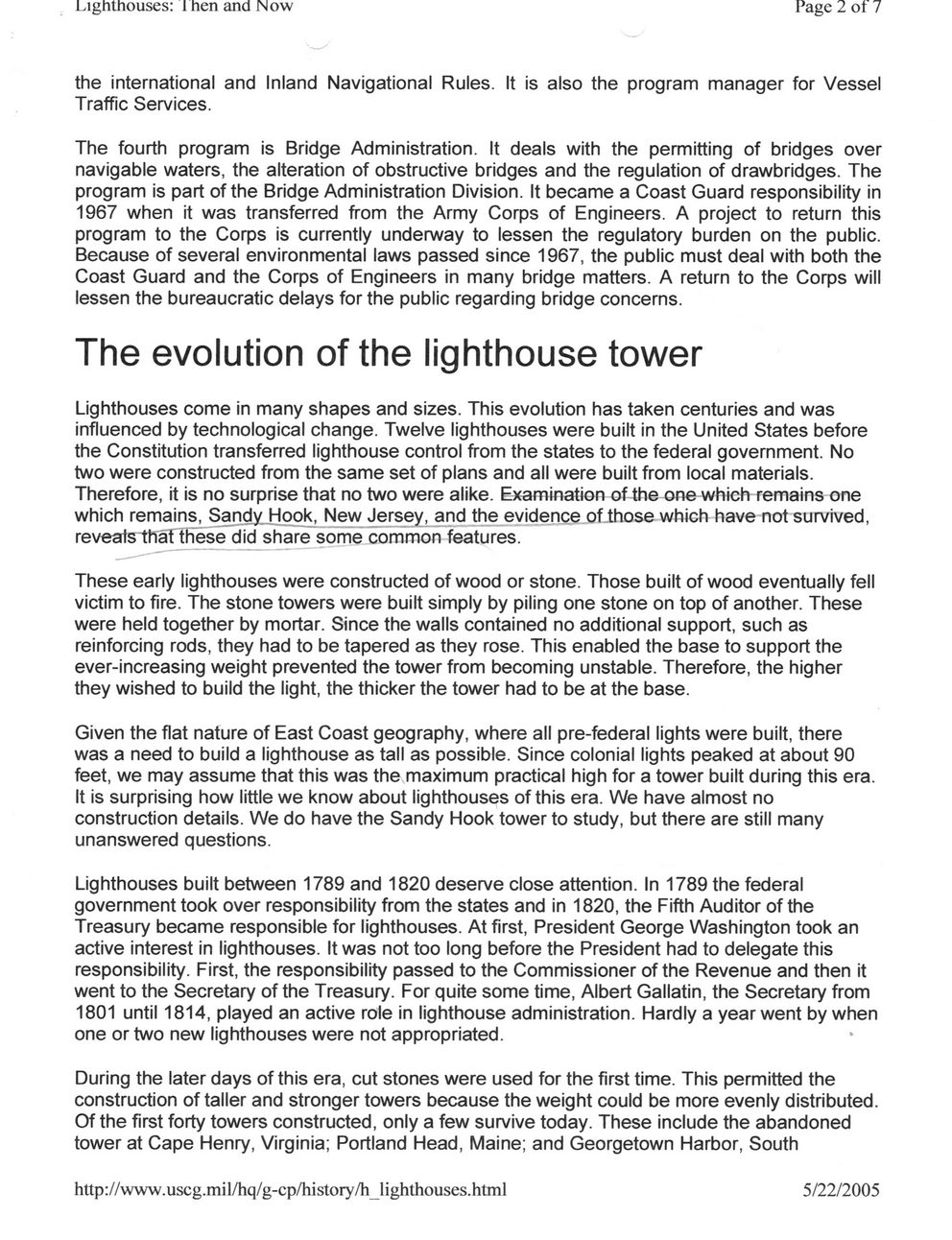This text was obtained via automated optical character recognition.
It has not been edited and may therefore contain several errors.
Lighthouses: 1 hen and Now Page 2 of 7 the international and Inland Navigational Rules. It is also the program manager for Vessel Traffic Services. The fourth program is Bridge Administration. It deals with the permitting of bridges over navigable waters, the alteration of obstructive bridges and the regulation of drawbridges. The program is part of the Bridge Administration Division. It became a Coast Guard responsibility in 1967 when it was transferred from the Army Corps of Engineers. A project to return this program to the Corps is currently underway to lessen the regulatory burden on the public. Because of several environmental laws passed since 1967, the public must deal with both the Coast Guard and the Corps of Engineers in many bridge matters. A return to the Corps will lessen the bureaucratic delays for the public regarding bridge concerns. The evolution of the lighthouse tower Lighthouses come in many shapes and sizes. This evolution has taken centuries and was influenced by technological change. Twelve lighthouses were built in the United States before the Constitution transferred lighthouse control from the states to the federal government. No two were constructed from the same set of plans and all were built from local materials. Therefore, it is no surprise that no two were alike. Examination of the one which remains one which remains^ Sandy Hook, New Jersey, and the evidence of those which have not survived, reveatsthalthese did share some common features. These early lighthouses were constructed of wood or stone. Those built of wood eventually fell victim to fire. The stone towers were built simply by piling one stone on top of another. These were held together by mortar. Since the walls contained no additional support, such as reinforcing rods, they had to be tapered as they rose. This enabled the base to support the ever-increasing weight prevented the tower from becoming unstable. Therefore, the higher they wished to build the light, the thicker the tower had to be at the base. Given the flat nature of East Coast geography, where all pre-federal lights were built, there was a need to build a lighthouse as tall as possible. Since colonial lights peaked at about 90 feet, we may assume that this was the maximum practical high for a tower built during this era. It is surprising how little we know about lighthouses of this era. We have almost no construction details. We do have the Sandy Hook tower to study, but there are still many unanswered questions. Lighthouses built between 1789 and 1820 deserve close attention. In 1789 the federal government took over responsibility from the states and in 1820, the Fifth Auditor of the Treasury became responsible for lighthouses. At first, President George Washington took an active interest in lighthouses. It was not too long before the President had to delegate this responsibility. First, the responsibility passed to the Commissioner of the Revenue and then it went to the Secretary of the Treasury. For quite some time, Albert Gallatin, the Secretary from 1801 until 1814, played an active role in lighthouse administration. Hardly a year went by when one or two new lighthouses were not appropriated. During the later days of this era, cut stones were used for the first time. This permitted the construction of taller and stronger towers because the weight could be more evenly distributed. Of the first forty towers constructed, only a few survive today. These include the abandoned tower at Cape Henry, Virginia; Portland Head, Maine; and Georgetown Harbor, South http://www.uscg.mil/hq/g-cp/history/h_lighthouses.html 5/22/2005

Lighthouses Chronology-of-Aids-to-Navigation-(02)-(1)